
Transmission provider Allison Transmission (NYSE: ALSN) announced better-than-expected revenue in Q4 CY2024, with sales up 2.7% year on year to $796 million. On the other hand, the company’s full-year revenue guidance of $3.25 billion at the midpoint came in 3.7% below analysts’ estimates. Its GAAP profit of $2.01 per share was 5.4% above analysts’ consensus estimates.
Is now the time to buy Allison Transmission? Find out by accessing our full research report, it’s free.
Allison Transmission (ALSN) Q4 CY2024 Highlights:
- Revenue: $796 million vs analyst estimates of $785 million (2.7% year-on-year growth, 1.4% beat)
- EPS (GAAP): $2.01 vs analyst estimates of $1.91 (5.4% beat)
- Adjusted EBITDA: $270 million vs analyst estimates of $270 million (33.9% margin, in line)
- Management’s revenue guidance for the upcoming financial year 2025 is $3.25 billion at the midpoint, missing analyst estimates by 3.7% and implying 0.8% growth (vs 6.3% in FY2024)
- EBITDA guidance for the upcoming financial year 2025 is $1.2 billion at the midpoint, below analyst estimates of $1.24 billion
- Operating Margin: 29.5%, in line with the same quarter last year
- Free Cash Flow Margin: 17.1%, down from 24% in the same quarter last year
- Market Capitalization: $9.89 billion
David S. Graziosi, Chair and Chief Executive Officer of Allison Transmission commented, "Closing out the year, unprecedented demand for Class 8 vocational vehicles persisted in the fourth quarter of 2024, leading to record full year net sales of $1.8 billion in our North America On-Highway end market. Driven by the realization of our growth initiatives, we achieved decade-high full year net sales in our Defense end market and all-time high full year net sales in our Outside North America On-Highway end market."
Company Overview
Helping build race cars at one point, Allison Transmission (NYSE: ALSN) offers transmissions to original equipment manufacturers and fleet operators.
Heavy Transportation Equipment
Heavy transportation equipment companies are investing in automated vehicles that increase efficiencies and connected machinery that collects actionable data. Some are also developing electric vehicles and mobility solutions to address customers’ concerns about carbon emissions, creating new sales opportunities. Additionally, they are increasingly offering automated equipment that increases efficiencies and connected machinery that collects actionable data. On the other hand, heavy transportation equipment companies are at the whim of economic cycles. Interest rates, for example, can greatly impact the construction and transport volumes that drive demand for these companies’ offerings.
Sales Growth
A company’s long-term sales performance signals its overall quality. Even a bad business can shine for one or two quarters, but a top-tier one grows for years. Regrettably, Allison Transmission’s sales grew at a sluggish 3.6% compounded annual growth rate over the last five years. This fell short of our benchmark for the industrials sector, but there are still things to like about Allison Transmission.
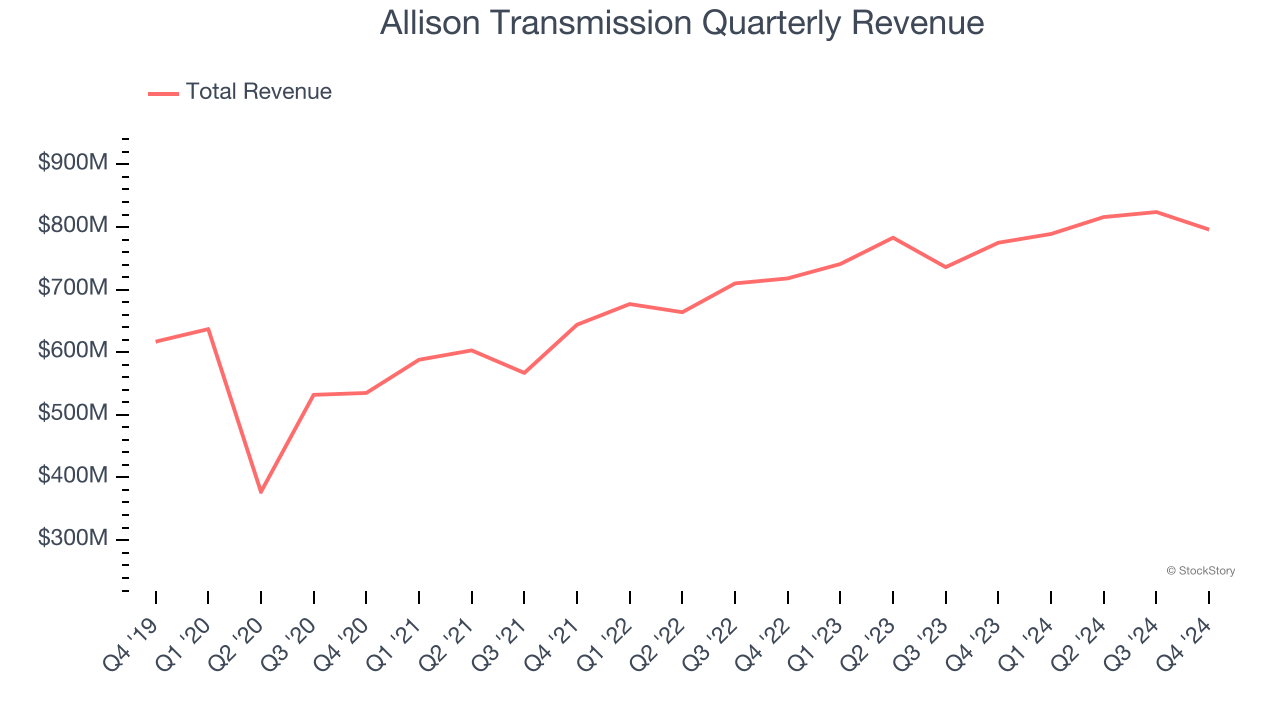
We at StockStory place the most emphasis on long-term growth, but within industrials, a half-decade historical view may miss cycles, industry trends, or a company capitalizing on catalysts such as a new contract win or a successful product line. Allison Transmission’s annualized revenue growth of 7.9% over the last two years is above its five-year trend, suggesting some bright spots. 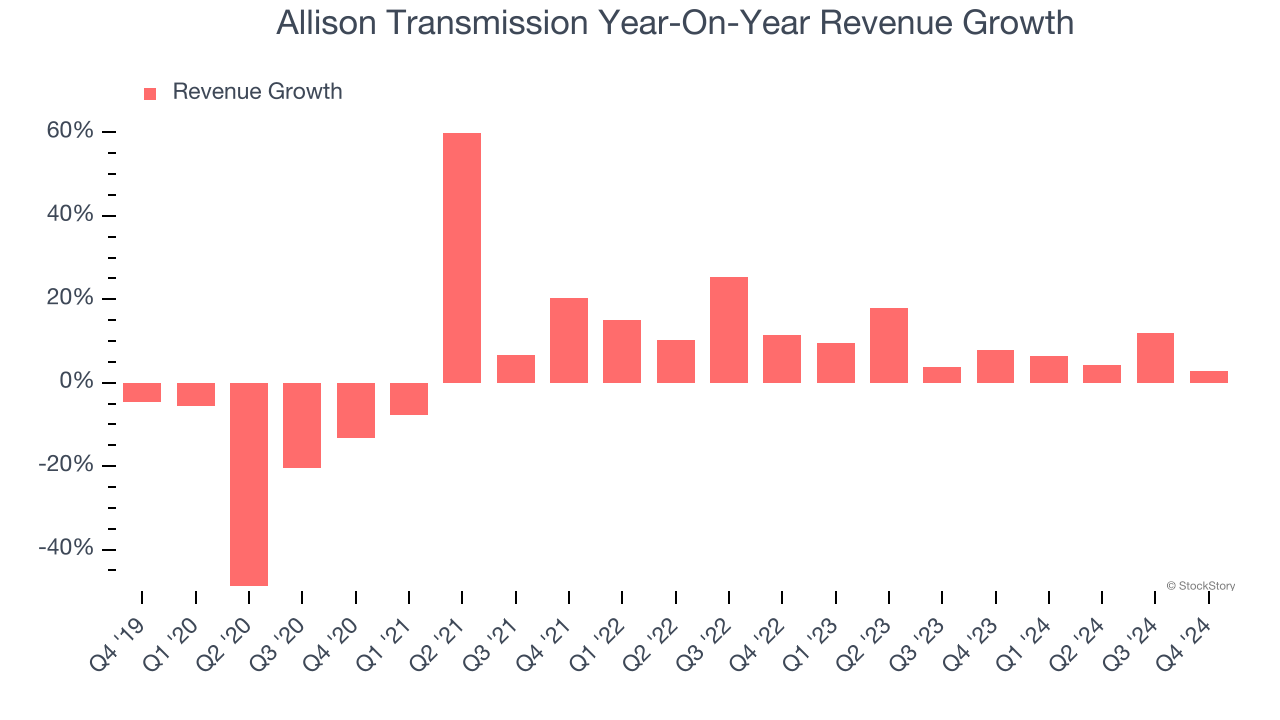
We can dig further into the company’s revenue dynamics by analyzing its three most important segments: North America On-Highway, International On-Highway, and Service and Support, which are 52.6%, 15.6%, and 21.2% of revenue. Over the last two years, Allison Transmission’s revenues in all three segments increased. Its North America On-Highway revenue (propulsion solutions) averaged year-on-year growth of 13.6% while its International On-Highway (propulsion solutions) and Service and Support (parts and equipment) revenues averaged 3.5% and 7.3%.
This quarter, Allison Transmission reported modest year-on-year revenue growth of 2.7% but beat Wall Street’s estimates by 1.4%.
Looking ahead, sell-side analysts expect revenue to grow 4.5% over the next 12 months, a deceleration versus the last two years. This projection doesn't excite us and indicates its products and services will see some demand headwinds. At least the company is tracking well in other measures of financial health.
Unless you’ve been living under a rock, it should be obvious by now that generative AI is going to have a huge impact on how large corporations do business. While Nvidia and AMD are trading close to all-time highs, we prefer a lesser-known (but still profitable) stock benefiting from the rise of AI. Click here to access our free report one of our favorites growth stories.
Operating Margin
Operating margin is one of the best measures of profitability because it tells us how much money a company takes home after procuring and manufacturing its products, marketing and selling those products, and most importantly, keeping them relevant through research and development.
Allison Transmission has been a well-oiled machine over the last five years. It demonstrated elite profitability for an industrials business, boasting an average operating margin of 28.8%. This result isn’t surprising as its high gross margin gives it a favorable starting point.
Analyzing the trend in its profitability, Allison Transmission’s operating margin rose by 5.1 percentage points over the last five years, showing its efficiency has meaningfully improved.
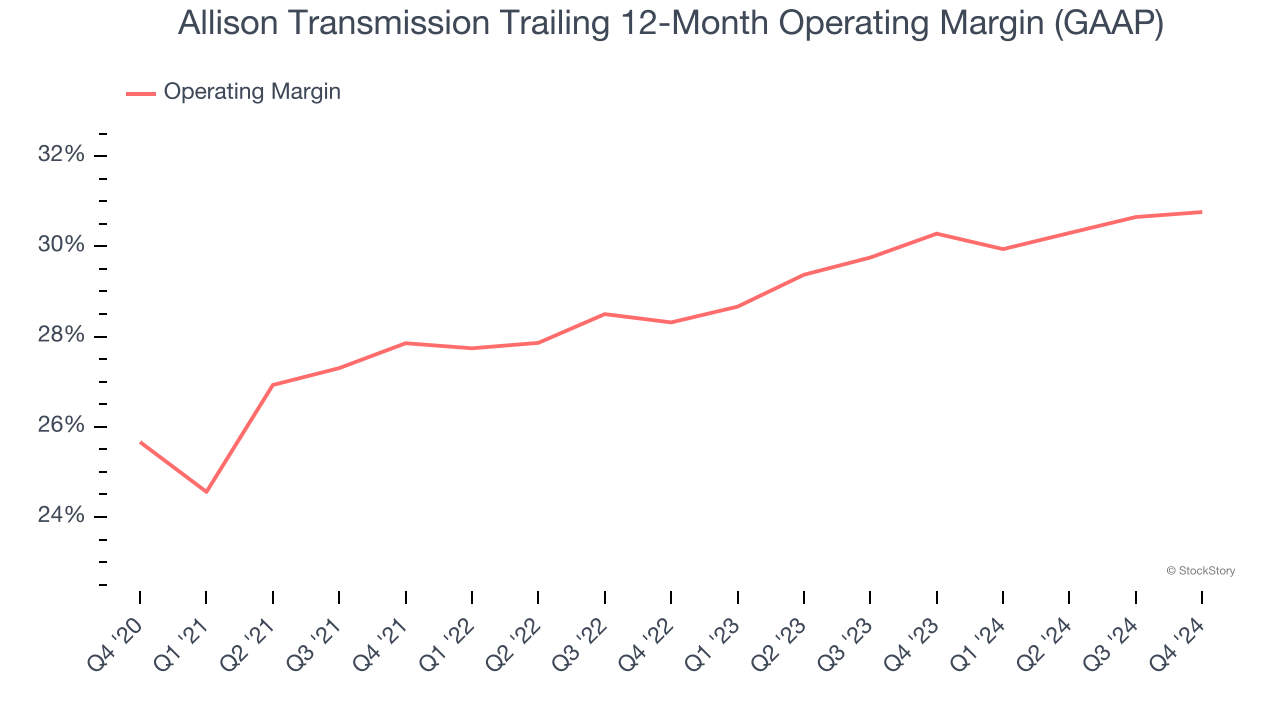
This quarter, Allison Transmission generated an operating profit margin of 29.5%, in line with the same quarter last year. This indicates the company’s cost structure has recently been stable.
Earnings Per Share
Revenue trends explain a company’s historical growth, but the long-term change in earnings per share (EPS) points to the profitability of that growth – for example, a company could inflate its sales through excessive spending on advertising and promotions.
Allison Transmission’s EPS grew at a solid 11.1% compounded annual growth rate over the last five years, higher than its 3.6% annualized revenue growth. This tells us the company became more profitable on a per-share basis as it expanded.
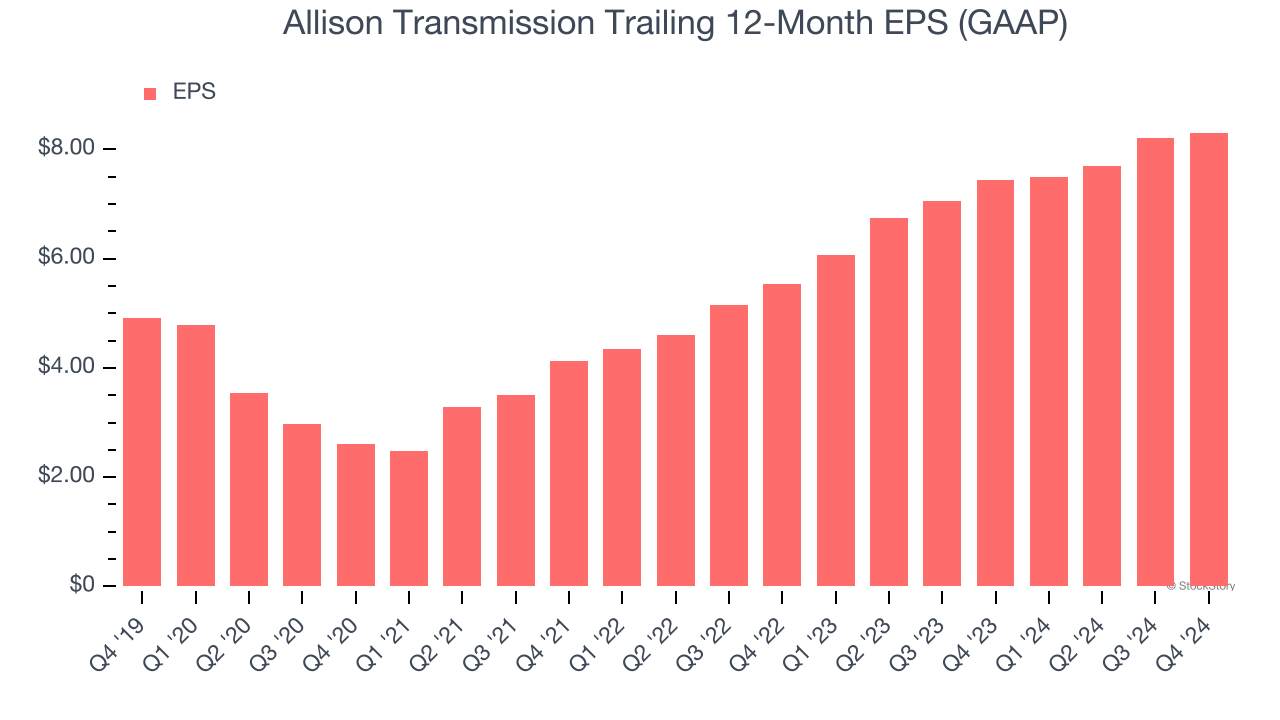
Diving into Allison Transmission’s quality of earnings can give us a better understanding of its performance. As we mentioned earlier, Allison Transmission’s operating margin was flat this quarter but expanded by 5.1 percentage points over the last five years. On top of that, its share count shrank by 26.9%. These are positive signs for shareholders because improving profitability and share buybacks turbocharge EPS growth relative to revenue growth. 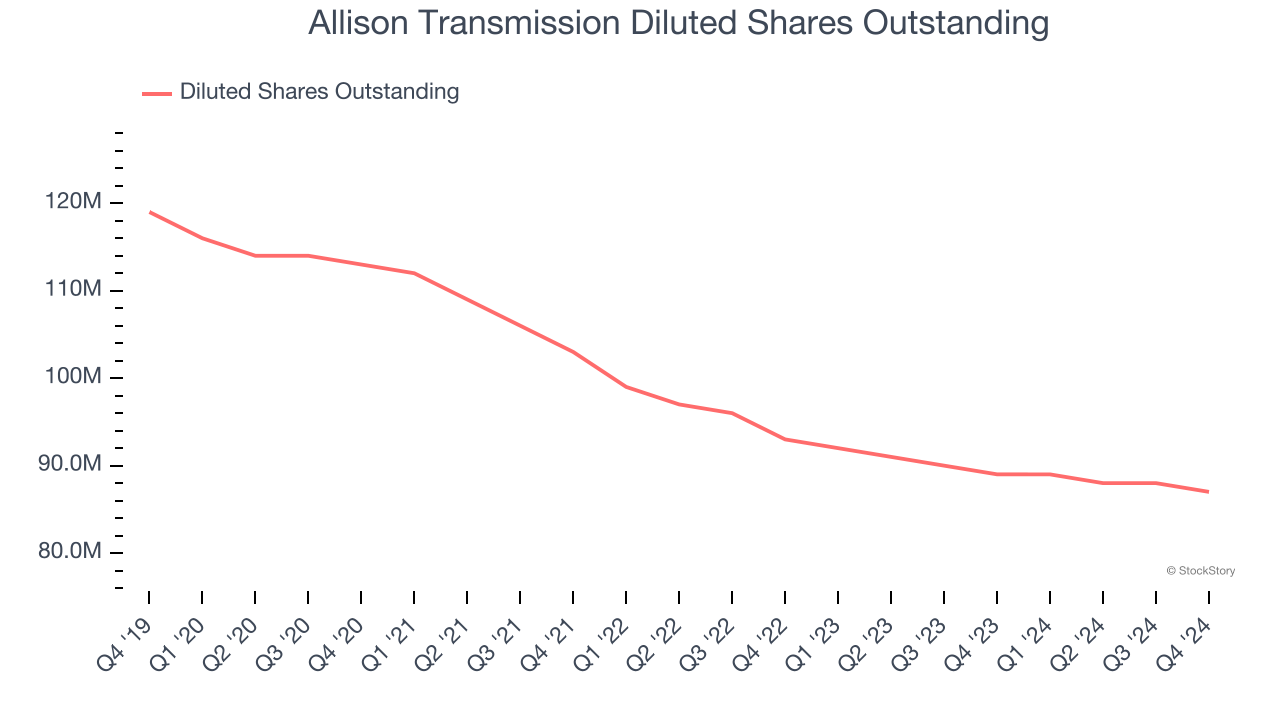
Like with revenue, we analyze EPS over a shorter period to see if we are missing a change in the business.
For Allison Transmission, its two-year annual EPS growth of 22.6% was higher than its five-year trend. We love it when earnings growth accelerates, especially when it accelerates off an already high base.
In Q4, Allison Transmission reported EPS at $2.01, up from $1.91 in the same quarter last year. This print beat analysts’ estimates by 5.4%. Over the next 12 months, Wall Street expects Allison Transmission’s full-year EPS of $8.31 to grow 13.1%.
Key Takeaways from Allison Transmission’s Q4 Results
It was good to see Allison Transmission narrowly top analysts’ revenue expectations this quarter. We were also glad its Service and Support revenue topped Wall Street’s estimates. On the other hand, its full-year revenue guidance missed significantly and its full-year EBITDA guidance fell short of Wall Street’s estimates. Overall, this was a weaker quarter. The stock traded down 8.1% to $104.95 immediately after reporting.
The latest quarter from Allison Transmission’s wasn’t that good. One earnings report doesn’t define a company’s quality, though, so let’s explore whether the stock is a buy at the current price. We think that the latest quarter is only one piece of the longer-term business quality puzzle. Quality, when combined with valuation, can help determine if the stock is a buy. We cover that in our actionable full research report which you can read here, it’s free.






